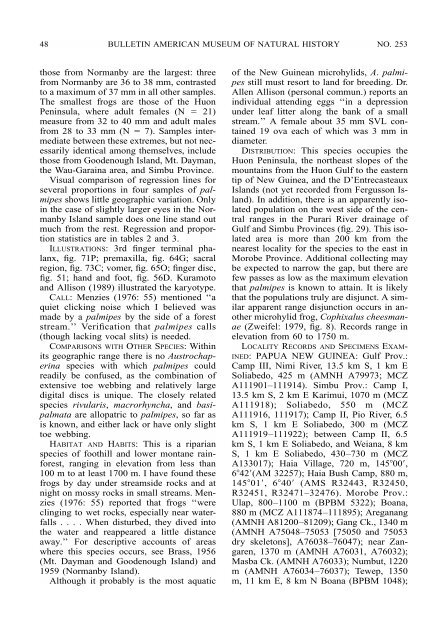SPHENOPHRYNE - American Museum of Natural History
SPHENOPHRYNE - American Museum of Natural History
SPHENOPHRYNE - American Museum of Natural History
Create successful ePaper yourself
Turn your PDF publications into a flip-book with our unique Google optimized e-Paper software.
48 BULLETIN AMERICAN MUSEUM OF NATURAL HISTORY NO. 253<br />
those from Normanby are the largest: three<br />
from Normanby are 36 to 38 mm, contrasted<br />
to a maximum <strong>of</strong> 37 mm in all other samples.<br />
The smallest frogs are those <strong>of</strong> the Huon<br />
Peninsula, where adult females (N 21)<br />
measure from 32 to 40 mm and adult males<br />
from 28 to 33 mm (N 7). Samples intermediate<br />
between these extremes, but not necessarily<br />
identical among themselves, include<br />
those from Goodenough Island, Mt. Dayman,<br />
the Wau-Garaina area, and Simbu Province.<br />
Visual comparison <strong>of</strong> regression lines for<br />
several proportions in four samples <strong>of</strong> palmipes<br />
shows little geographic variation. Only<br />
in the case <strong>of</strong> slightly larger eyes in the Normanby<br />
Island sample does one line stand out<br />
much from the rest. Regression and proportion<br />
statistics are in tables 2 and 3.<br />
ILLUSTRATIONS: 3rd finger terminal phalanx,<br />
fig. 71P; premaxilla, fig. 64G; sacral<br />
region, fig. 73C; vomer, fig. 65O; finger disc,<br />
fig. 51; hand and foot, fig. 56D. Kuramoto<br />
and Allison (1989) illustrated the karyotype.<br />
CALL: Menzies (1976: 55) mentioned ‘‘a<br />
quiet clicking noise which I believed was<br />
made by a palmipes by the side <strong>of</strong> a forest<br />
stream.’’ Verification that palmipes calls<br />
(though lacking vocal slits) is needed.<br />
COMPARISONS WITH OTHER SPECIES: Within<br />
its geographic range there is no Austrochaperina<br />
species with which palmipes could<br />
readily be confused, as the combination <strong>of</strong><br />
extensive toe webbing and relatively large<br />
digital discs is unique. The closely related<br />
species rivularis, macrorhyncha, and basipalmata<br />
are allopatric to palmipes, so far as<br />
is known, and either lack or have only slight<br />
toe webbing.<br />
HABITAT AND HABITS: This is a riparian<br />
species <strong>of</strong> foothill and lower montane rainforest,<br />
ranging in elevation from less than<br />
100 m to at least 1700 m. I have found these<br />
frogs by day under streamside rocks and at<br />
night on mossy rocks in small streams. Menzies<br />
(1976: 55) reported that frogs ‘‘were<br />
clinging to wet rocks, especially near waterfalls<br />
. . . . When disturbed, they dived into<br />
the water and reappeared a little distance<br />
away.’’ For descriptive accounts <strong>of</strong> areas<br />
where this species occurs, see Brass, 1956<br />
(Mt. Dayman and Goodenough Island) and<br />
1959 (Normanby Island).<br />
Although it probably is the most aquatic<br />
<strong>of</strong> the New Guinean microhylids, A. palmipes<br />
still must resort to land for breeding. Dr.<br />
Allen Allison (personal commun.) reports an<br />
individual attending eggs ‘‘in a depression<br />
under leaf litter along the bank <strong>of</strong> a small<br />
stream.’’ A female about 35 mm SVL contained<br />
19 ova each <strong>of</strong> which was 3 mm in<br />
diameter.<br />
DISTRIBUTION: This species occupies the<br />
Huon Peninsula, the northeast slopes <strong>of</strong> the<br />
mountains from the Huon Gulf to the eastern<br />
tip <strong>of</strong> New Guinea, and the D’Entrecasteaux<br />
Islands (not yet recorded from Fergusson Island).<br />
In addition, there is an apparently isolated<br />
population on the west side <strong>of</strong> the central<br />
ranges in the Purari River drainage <strong>of</strong><br />
Gulf and Simbu Provinces (fig. 29). This isolated<br />
area is more than 200 km from the<br />
nearest locality for the species to the east in<br />
Morobe Province. Additional collecting may<br />
be expected to narrow the gap, but there are<br />
few passes as low as the maximum elevation<br />
that palmipes is known to attain. It is likely<br />
that the populations truly are disjunct. A similar<br />
apparent range disjunction occurs in another<br />
microhylid frog, Cophixalus cheesmanae<br />
(Zweifel: 1979, fig. 8). Records range in<br />
elevation from 60 to 1750 m.<br />
LOCALITY RECORDS AND SPECIMENS EXAM-<br />
INED: PAPUA NEW GUINEA: Gulf Prov.:<br />
Camp III, Nimi River, 13.5 km S, 1 km E<br />
Soliabedo, 425 m (AMNH A79973; MCZ<br />
A111901–111914). Simbu Prov.: Camp I,<br />
13.5 km S, 2 km E Karimui, 1070 m (MCZ<br />
A111918); Soliabedo, 550 m (MCZ<br />
A111916, 111917); Camp II, Pio River, 6.5<br />
km S, 1 km E Soliabedo, 300 m (MCZ<br />
A111919–111922); between Camp II, 6.5<br />
km S, 1 km E Soliabedo, and Weiana, 8 km<br />
S, 1 km E Soliabedo, 430–730 m (MCZ<br />
A133017); Haia Village, 720 m, 14500,<br />
642(AM 32257); Haia Bush Camp, 880 m,<br />
14501, 640 (AMS R32443, R32450,<br />
R32451, R32471–32476). Morobe Prov.:<br />
Ulap, 800–1100 m (BPBM 5322); Boana,<br />
880 m (MCZ A111874–111895); Areganang<br />
(AMNH A81200–81209); Gang Ck., 1340 m<br />
(AMNH A75048–75053 [75050 and 75053<br />
dry skeletons], A76038–76047); near Zangaren,<br />
1370 m (AMNH A76031, A76032);<br />
Masba Ck. (AMNH A76033); Numbut, 1220<br />
m (AMNH A76034–76037); Tewep, 1350<br />
m, 11 km E, 8 km N Boana (BPBM 1048);
















